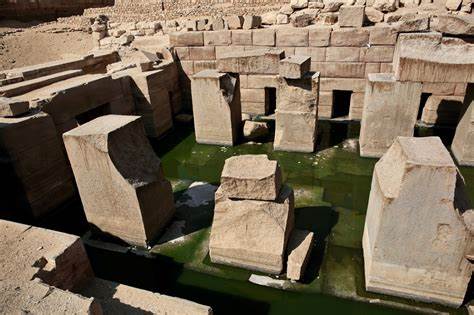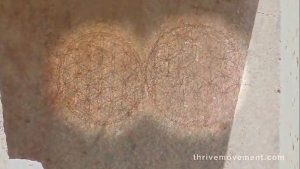hieroglyphics
Deer
Deer(Greek elephos) are apparently not mentioned in his Atlantis narrative, however, he does refer to elephants (elephas). Jürgen Spanuth, who advocated a North-West Europe location for Atlantis was unable to satisfactorily reconcile his Helgoland location with Plato’s elephants. Now another German researcher, Eckart Kahlhofer, has offered a simple explanation, namely that a transcription error led to the Greek word for elephant (elephas) being mistaken for their word for deer (elephos). However, as Atlantis story originated in Egypt, what may be more relevant is the fact that the Egyptian hieroglyphics for deer (seshau) and elephant (abu) are so totally different that confusion between the two is not possible.
The elk was the largest species of deer in Northern Europe and is still found in Scandinavia. The Great Irish Deer which died out around 5500 BC was 10 feet (3 metres) tall and had an antler span of 11 feet.
Crombette, Fernand
 Fernand Crombette (1880-1970) was a French priest, who has written over thirty books on a wide range of subjects, frequently under the pen-name of ‘A French Catholic’.
Fernand Crombette (1880-1970) was a French priest, who has written over thirty books on a wide range of subjects, frequently under the pen-name of ‘A French Catholic’.
In 1995 a book by Noël Derose entitled If the World Only Knew[1367] was published, which reviewed the life and work of Crombette.
The subject matter of Crombette’s work ranges from Egyptology to Easter Island and from hieroglyphics to Atlantis. Crombette placed Atlantis in the Atlantic (see map). According to Crombette, Atlantis sank at the same time as the Israelite crossing of the Red Sea, which also coincided with the voyage of Jason and the Argonauts and the drying up of the Scythian Ocean(c).
There are a number of websites(a)(b) dedicated to his rather eccentric views. ?
(a) See: https://web.archive.org/web/20181231035759/https://ceshe-usa.org/
Abydos *
Abydos, known locally as Umm el-Qa’ab, is a site in Upper Egypt that contains a variety of structures including the Osirion, which is alleged to be the burial-place of Osiris, the Egyptian deity who was the father of Horus and the brother and husband of Isis. It was discovered in 1901/2 by Sir William Flinders Petrie (1853-1942) and Margaret Alice Murray (1863-1963)(c).
An illustrated tour of the Abydos Temple of Seti I and the Osirion is offered by Jimmy Dunn, writing as Peter Rome(t).
 The Osirion (Osireion) has several unusual features that have led some, such as John Anthony West(a) to reasonably conclude that it is from a much earlier or at least a different period than the adjacent Temple of Seti I.
The Osirion (Osireion) has several unusual features that have led some, such as John Anthony West(a) to reasonably conclude that it is from a much earlier or at least a different period than the adjacent Temple of Seti I.
This view is based on at least three observations.
 (i) The foundations of the Osirion are much lower than those of the Temple of Seti, a feature that would have been unprecedented. It is more likely that the structure was originally designed to be built at ground level in a conventional manner. However, after construction, the ground level rose over succeeding years with the deposits of silt from the annual inundation by the Nile. Consequently, when the adjacent Temple of Seti was built, a considerable number of years later, it was erected on the much higher ground beside a buried Osirion.
(i) The foundations of the Osirion are much lower than those of the Temple of Seti, a feature that would have been unprecedented. It is more likely that the structure was originally designed to be built at ground level in a conventional manner. However, after construction, the ground level rose over succeeding years with the deposits of silt from the annual inundation by the Nile. Consequently, when the adjacent Temple of Seti was built, a considerable number of years later, it was erected on the much higher ground beside a buried Osirion.
(ii) The Temple of Seti has an unusual unique outline being ‘L’ shaped instead of having the usual rectangular form. This would seem to suggest that during the construction of the temple, the builders discovered the buried Osirion and had to alter the original design.
(iii) For some, the most compelling reason for dating the Osirion differently to Seti’s Temple is that stylistically the structure is totally at variance with anything else from Seti’s era.
In response to the last point, conventional archaeologists have proposed that “the Osireion was purposely archaized by New Kingdom architects to make it appear to be ancient. Such a design would be appropriate for the tomb of an ancient god. Any resemblance to Khafre’s Valley Temple, then, would be purely intentional.”
A 2006 article pointed out that “the Osirion is the only temple known from Ancient Egypt to be built below ground level!(o)
In 1995, Graham Hancock drew attention[275] to this difference in style and a 2019 article, Freddy Silva also commented on this incongruity(h)(k), but notes that while the Osirion at first sight, does not appear to have any obvious astronomical alignment, “only in the epoch of 10,000 BC do connections begin to emerge, for the constellation Cygnus appears in full upright ascent over the horizon in conjunction with the axis of the temple, the entrance framing its brightest star, Deneb.”
Silva added that the Osirion “represents a complete departure from standard temple design. However, a geological appraisal contradicts this opinion. In ancient times the level of the Nile was fifty feet lower than today, its course seven miles closer to and beside the Osirion. When North Africa was subjected to major flooding between 10,500-8000 BC, layers of Nile silt gradually compacted and rose inch by inch until they surrounded and covered the Osirion. In other words, the temple was originally a freestanding feature on the floodplain.”
On cue(i), Jason Colavito attacked Silva, pointing out a bad mistake where Silva incorrectly quoted Diodorus Siculus, subtly implying that everything else that he wrote was also erroneous.
As noted above, it is argued(d). that the apparently archaic architecture of the Osirion is just an example of how “the Egyptians had a recurring tendency to build in a ‘pseudo-archaic’ style”, noting that the style of the temple of Khafre in Giza resembles the Osirion. If so, which was copying which? While Khafre’s temple is adorned with hieroglyphics the apparent absence of any contemporary hieroglyphics in the Osirion seems to suggest a preliterate period for its construction!
The Valley Temple and the Sphinx Temple at Giza show similar construction techniques and are also devoid of inscriptions. As I see it, there is no unequivocal evidence on offer to demonstrate that the Osirion could not be much earlier than the nearby Seti Temple. Therefore, I would urge caution before hastily dismissing Hancock, Silva and others regarding this matter.
The conventional view that Seti I was responsible for the building of both the Temple and the Osireion is expressed in a well-illustrated paper by Keith Hamilton on the Academia.edu website(j).
This suggestion of an earlier date, such as in Ralph Ellis’ Thoth, the Architect of the Universe [0517], has added weight to the more general claim that other Egyptian monuments such as the Sphinx and some of the lower courses of the Great Pyramid are also from a predynastic era. This is interpreted by some as evidence of an early civilisation that might be more in keeping with the 9600 BC date in the story of Atlantis told to Solon by the Egyptian priests at Sais. Brien Foerester has also advocated an early date for the Osirion(n).
 Another feature that appears to be unique to the Osirion is drawings of the ‘Flower of Life’ (FoL) on one of its pillars! Gary Fletcher touched on this in a 2009 paper(s). However, it is impossible to say when they were placed there. David Furlong has posted an article on the (FoL), noting particularly that some Greek letters have been identified inscribed beside the FoL design. This may suggest that the badly worn lettering was added long ofter the construction of the Osirion(u). Also on Furlong’s site we have an article by Malcolm Stewart describing the circle clusters and Greek writing as graffiti, possibly dating to the 3rd or 2nd centuries BC(v)!
Another feature that appears to be unique to the Osirion is drawings of the ‘Flower of Life’ (FoL) on one of its pillars! Gary Fletcher touched on this in a 2009 paper(s). However, it is impossible to say when they were placed there. David Furlong has posted an article on the (FoL), noting particularly that some Greek letters have been identified inscribed beside the FoL design. This may suggest that the badly worn lettering was added long ofter the construction of the Osirion(u). Also on Furlong’s site we have an article by Malcolm Stewart describing the circle clusters and Greek writing as graffiti, possibly dating to the 3rd or 2nd centuries BC(v)!
A sceptic’s view of the claimed early date for the Osirion can be read online(d).
It is worth noting that Abydos was also the site of a remarkable discovery of 14 buried boats that have been dated to at least 3000BC and again possibly even pre-dynastic.
Klaus H. Aschenbrenner has produced an Internet article, Giza and Abydos: The Keys to Atlantis, unfortunately in German only, which bravely promotes the idea of an 11th millennium BC date for parts of both Giza and Abydos.
Hieroglyphics in the Temple of Seti at Abydos have also been seized upon by proponents of ancient technology existing in prehistoric times and possible links to a hi-tech Atlantis. These carvings suggest the outline of a helicopter and a submarine! A refutation of this interpretation, by Margaret Morris(b) and others(e)(f), has demonstrated that the carvings have been reworked and that some of the plaster infills had deteriorated. This helicopter claim has been successfully debunked on a number of sites(q), including a December 2022 posting on The Archaeologist website(r), which is particularly graphic. Furthermore, there is clear evidence that images of the hieroglyphics circulating on the internet were digitally ‘tidied up’.
Wayne James Howson offers some radical ideas concerning the Osireion in a 400-page book available on the Academia.edu website(l). Howson was influenced by the work of Jim Westerman(m).
In November 2016, it was announced that a city was unearthed not far from the Abydos temples, where “it is believed the city was home to important officials and tomb builders and would have flourished during early-era ancient Egyptian times.(g)“
(a) http://www.jawest.net/hall_of_maat.htm
(b) See Archive 2727
(c) https://ascendingpassage.com/Osirion-at-Abydos.htm
(d) https://rationalwiki.org/wiki/Osireion,
(e) https://rationalwiki.org/wiki/Abydos_helicopter
(f) http://www.catchpenny.org/abydos.html
(g) https://www.bbc.com/news/world-middle-east-38084391
(h) https://grahamhancock.com/silvaf4/
(j) https://www.academia.edu/37568156/The_Osireion_A_Laymans_Guide
(k) https://www.ancient-origins.net/history/osirion-abydos-0012397
(m) https://jameswesterman.org/?p=home
(n) Ancient Egypt: The Osirion And The “Mystery ” of the “Flower Of Life” Symbols – Hidden Inca Tours
(o) http://egyptiansecrets.blogspot.com/2006/02/mysterious-osirion-at-abydos.html
(p) Who built the Osireion? (catchpenny.org)
(q) http://www.fineart.be/UfocomHQ/usabydos.htm (link broken)
(r) https://www.thearchaeologist.org/blog/the-abydos-helicopter-hieroglyphics
(t) http://www.touregypt.net/featurestories/setiabydos.htm
(u) The Osirion and the Flower of Life (davidfurlong.co.uk)
(v) The Flower of Life – Malcolm Stewart Article (davidfurlong.co.uk)

